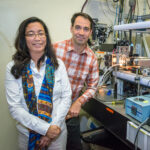The projects of 23 Biosciences Area scientists and engineers received funding through the FY25 Laboratory Directed Research and Development (LDRD) program.
Structural Biology Brings Chemotherapy Resistance Into High Resolution
Biosciences researchers conducted the first ever structural analysis of a key protein involved in DNA damage repair and cancer. While the narrative around cancer chemotherapy has historically focused on DNA damage repair pathways, findings from this study underscore the role of RNA-mediated processes on chemotherapy response, which could have major implications for cancer treatment outcomes.
Biosciences Area FY24 LDRD Projects
The projects of 21 Biosciences Area scientists and engineers received funding through the FY24 Laboratory Directed Research and Development (LDRD) program.
Hura, Tsutakawa named Science Deputy, Structural Biology Department Head
Molecular Biophysics and Integrated Bioimaging (MBIB) Division Director Junko Yano has announced that staff scientists Greg Hura and Susan Tsutakawa have officially assumed the roles of MBIB Science Deputy and Head of the Structural Biology Department, respectively. They have been serving in these positions on an interim basis since August 2021.
Biosciences Area and Molecular Biophysics and Integrated Bioimaging Division Leadership Changes
Mary Maxon, Associate Laboratory Director (ALD) for Biosciences, has been granted a one-year leave of absence to help advance science and technology opportunities for engineering biology and the U.S. bioeconomy. Beginning August 23, Maxon will work on temporary assignment with Schmidt Futures, a philanthropic initiative founded by Eric and Wendy Schmidt, as they launch a significant effort to seed the next wave of engineering biology and bioeconomy innovation.
Paul Adams, Director of the Molecular Biophysics and Integrated Bioimaging (MBIB) Division, has been asked by Lab Director Mike Witherell to serve as the ALD for Biosciences over the coming year. While Adams is serving as Biosciences ALD, MBIB Deputy for Science Junko Yano will take on the role of Interim MBIB Division Director; Greg Hura has agreed to step into the role of Interim MBIB Science Deputy; and Susan Tsutakawa will be the Interim Head of the Structural Biology Department for the coming year.
Was this page useful?







